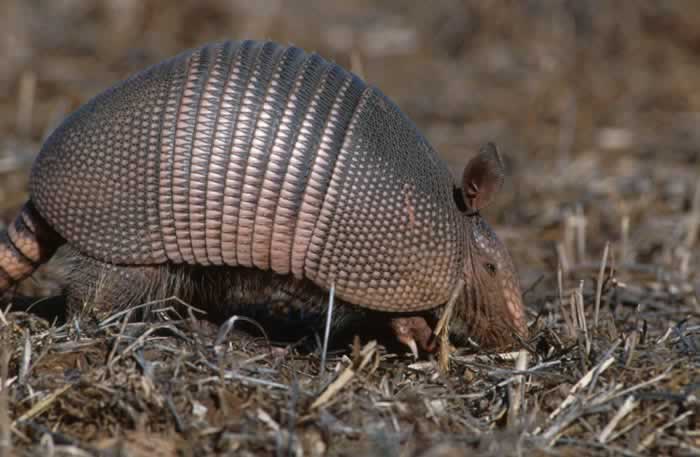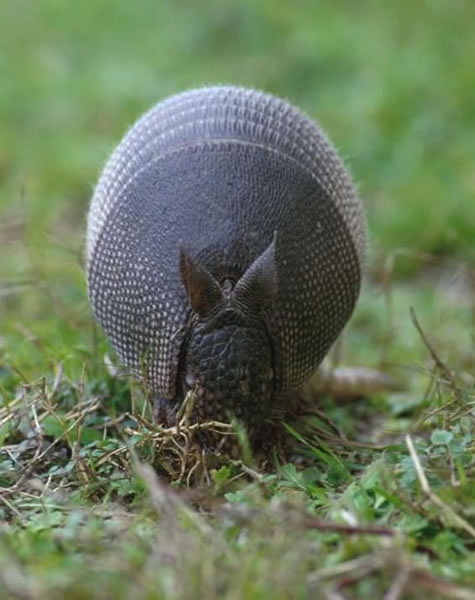
U.S. Fish and Wildlife Service
Physical Description:
The nine-banded armadillo is a cat-sized mammal that is covered with
a scaled shell, or carapace, that protects it from predators.
It ranges in color from brownish-black to grey, with yellowish white
hair on its underside. The carapace is constructed of tough,
leathery skin and dermal plates on its back, head, tail, and sides.
The nine-banded armadillo has nine jointed bands across its midsection
which allow for flexibility in movement. This armadillo ranges in size
from 15-17 inches in length, with a ringed tail that measures between
14-16 inches long. The nine-banded armadillo has four toes on
each of its front feet and five toes on each of its hind feet.
It also has strong claws for digging and burrowing. The armadillo
has a small head with long ears and a pointed snout that it uses to
forage for food.
Social Organization::
Armadillos build dens uderground to sleep in. They will often
share their dens with other armadillos as well as with other animals,
such as skunks, rabbits, and oppossums. Armadillos are not territorial.
Armadillos are mostly nocturnal and use their specialized hearing and
smell to make their way around after dark.
Special Adaptations:
Contrary to popular belief, the nine-banded armadillo cannot roll itself
into a ball for protection. When chased by a predator into a burrow,
the armadillo can wedge itself into the tunnel with its back to
the outside. This makes it almost impossible to dislodge.
When confronted by a stream or river crossing, the armadillo has two
approaches. If the water is shallow, it will simply walk across
the bottom. In order to cross deeper or wider waterways, the armadillo
can swim across much like a dog. It is able to do this thanks
to its ability to gulp air and inflate its digestive tract. Unfortunately,
man is the armadillo's greatest predator. Armadillos are hunted
for food in many areas of Mexico and parts of Texas, but are most often
killed by cars in the United States.
Reproductive Behavior:
Typically female armadillos mate with only one male and they may even
share a den during the mating season. Reproduction in the armadillo
is characterized by a period of delayed implantation. The embryo
does not implant until 14 weeks after fertilization has occurred.
Approximately 4 months later, the female armadillo gives birth to four
identical young who are born fully developed and with their eyes open.
The young are able to walk within a few hours after birth and can begin
to forage with their mother in just a few weeks. The skin of newborn
armadillos is soft at birth, but hardens as they grow older. They
continue to nurse for about two months and may stay with their mother
for several months afterwards. Armadillos reach sexual maturity
at about one year of age.
The Animal at the Zoo:
The nine-banded armadillo resides in the Texas Wild Petting Corral at
the Ft. Worth Zoo. The handlers bring him out during the afternoon,
so he is readily available for observation and petting. Since
armadillos tend to be nocturnal, this guy likes to sleep and take it
easy during the day.
Page Author:
Cindi Nichols: cknloohoo1@aol.com
Sources and Links:
http://www.nsrl.ttu.edu/tmot1/dasynove.htm
http://www.tpwd.state.tx.us/nature/wild/vertebrate/
mammals/dillo.htm
http.//animaldiversity.ummz.umich.edu/site/accounts/
information/Dasypus_novemcinctus.html
